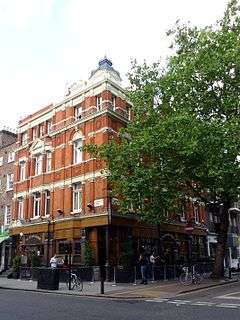Fitzroy Tavern
The Fitzroy Tavern[1] is a public house situated at 16 Charlotte Street in the Fitzrovia district of central London, England, to which it gives its name.
| Fitzroy Tavern | |
|---|---|
 Fitzroy Tavern in 2009 | |
 Fitzroy Tavern  Fitzroy Tavern | |
| General information | |
| Type | Public house |
| Address | 16 Charlotte Street |
| Town or city | London |
| Country | England |
| Coordinates | 51.5186°N 0.1347°W |
It is currently owned by the Samuel Smith Brewery. It became famous during a period spanning the 1920s to the mid-1950s as a meeting place for many of London's artists, intellectuals and bohemians such as Jacob Epstein, Nina Hamnett, Dylan Thomas, Augustus John, and George Orwell.
It is named either directly or indirectly after the Fitzroy family, Dukes of Grafton, who owned much of the land on which Fitzrovia was built.
The building was originally constructed as the Fitzroy Coffee House, in 1883, and converted to a pub (called "The Hundred Marks") in 1887, by W. M. Brutton. In the early years of the 20th century, Judah Morris Kleinfeld became licensee. He rebranded it the "Fitzroy Tavern" in March 1919. The licence then passed to his daughter and her husband Charles Allchild who ran it into the 1950s.
His granddaughter Sally Fiber who worked behind the bar from a very young age eventually wrote a history of the pub [2] "The Fitzroy: The Autobiography of a London Tavern" with the help of Clive Powell-Williams. Now re-published in September 2014 with up-dated content by Sally with help from DeSapinaud Productions. There are photographs on the walls of both Michael Bentine and Dylan Thomas drinking in the pub.
It makes an appearance in the high-resolution picture of London taken in 2012 as a part of the Cities 360 project hosted by BT. This project shows the largest panorama of London most recently produced from the top of the BT Tower.
Since 2000 it has been the home of the Pear Shaped Comedy Club which runs every Wednesday in the downstairs bar.[3]
In 2018, the pub was given a pub design award by CAMRA for its recent refurbishment, in which its original Victorian appearance was retained and revived.[4] Polished mahogany partitions with acid-etched glass were installed downstairs to recreate the original snugs, while wrought-iron pub signs in keeping with the originals were erected outside.
References
- Fitzroy Tavern, Fitzrovia, London W1T 2NA.
- "The Fitzroy: An autobiography of a London Tavern".
- "Pearshaped Comedy Club home page". Retrieved 21 January 2001.
- Rebecca Smithers. "London pub's Victorian makeover wins Camra design award | Life and style". The Guardian. Retrieved 27 March 2018.